10 best Mailchimp alternatives for effective email marketing
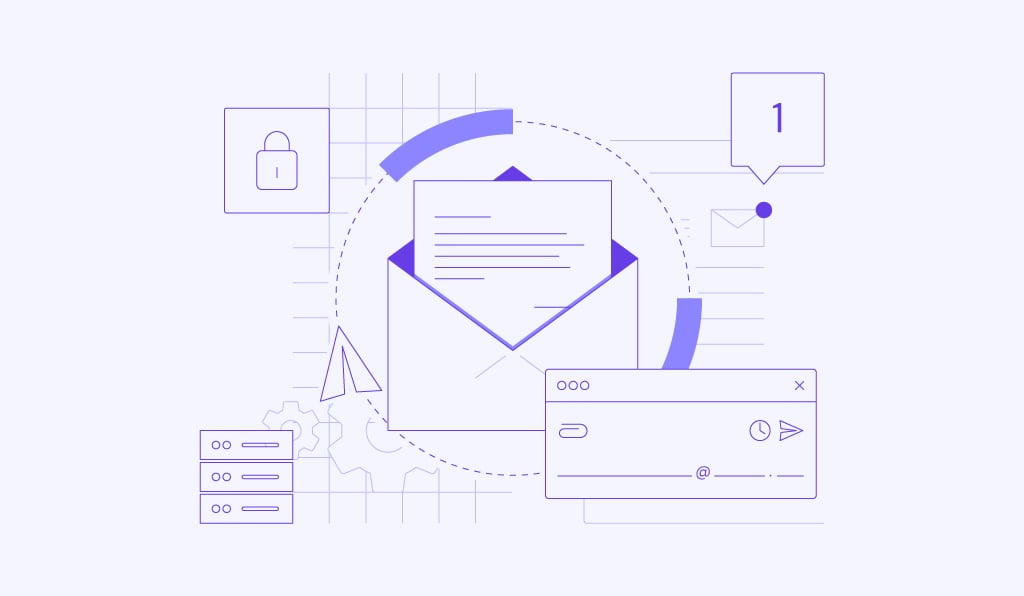
Mailchimp is a popular email marketing platform that helps businesses send newsletters, automate campaigns, and manage subscriber lists.
While Mailchimp does a great job for simple newsletters and has strong brand recognition, costs climb quickly once you need automation or have more than a few thousand subscribers.
On top of that, users report the platform can feel complex for simple tasks while simultaneously lacking the deep ecommerce or B2B features that Mailchimp competitors now offer.
The good news is that there are excellent alternatives to Mailchimp that address these specific issues. You’ll find services like Hostinger Reach for its AI features, Omnisend for ecommerce, and Brevo for its cost-effective pricing.
Top Mailchimp alternatives include:
- Best for AI-powered content: ✨ Hostinger Reach, for its built-in AI writer to generate emails quickly.
- Best for ecommerce: 🛍️ Omnisend, for deep store integration and omnichannel marketing.
- Best for budget-friendly scaling: 💰 Brevo, offering a “pay-as-you-send” model that’s cheaper for large lists.
- Best for advanced automation: 🤖 ActiveCampaign, with a best-in-class visual workflow builder.
- Best for beginners and creators: ✍️ MailerLite, thanks to its simple interface and generous free plan.
Let’s find the one that’s right for you.
1. Hostinger Reach
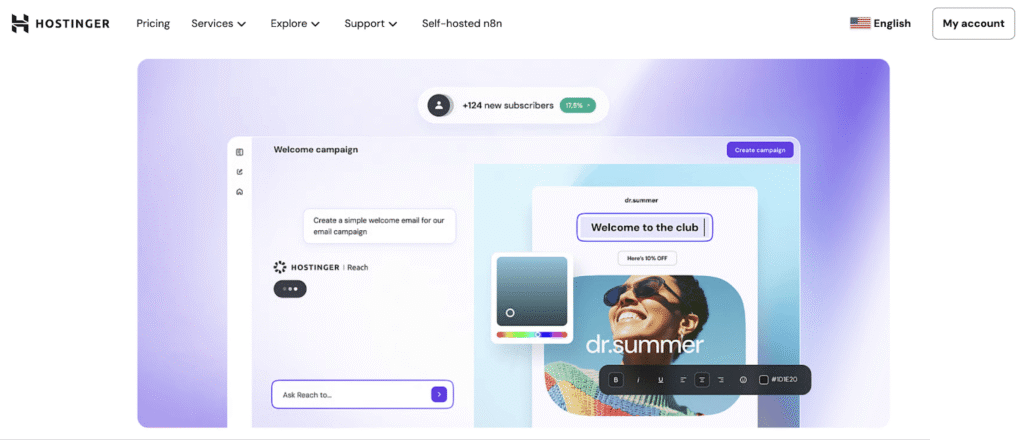
Hostinger Reach is an AI-powered email marketing tool designed to simplify content creation and campaign management. It’s built for speed and ease of use, making it the ideal choice for business owners who want to create effective emails without a steep learning curve.
Key features of Hostinger Reach:
- Integrated AI builder: Generates entire email campaigns, subject lines, and content from simple prompts, a feature that Mailchimp is still catching up on.
- Automatic brand styling: Set your logo and brand colors once, and Reach automatically applies them to all email templates.
- Seamless connections: Features one-click domain authentication for deliverability and automatically syncs new contacts from Hostinger Website Builder and WordPress sites.
Limitations of Hostinger Reach:
- Fewer integrations: It doesn’t have the extensive library of third-party integrations that Mailchimp offers.
- Simpler automation: It lacks the more advanced automation workflows available in Mailchimp’s Standard or Premium plans.
Hostinger Reach pricing:
Pricing is straightforward, starting at $5.99/month, with a one-year free trial available. The tool is offered in simple, predictable plans, which contrasts with Mailchimp’s multi-tiered pricing that scales quickly.

2. Omnisend

Omnisend is one of the best Mailchimp competitors for ecommerce businesses, especially those using WooCommerce or BigCommerce. The entire platform is built around one goal: helping online stores drive more sales.
Key features of Omnisend:
- Omnichannel marketing: You can combine email, SMS, and web push notifications into a single automated workflow, which Mailchimp doesn’t offer in such a streamlined way.
- Deep ecommerce segmentation: It offers much deeper segmentation based on real-time shopping behavior than Mailchimp does. For example, you can create specific segments for customers who viewed certain products or added other products to their cart.
- Sales-focused templates: Features like product pickers and unique discount code generators are built in to drive sales, making it one of the most effective email marketing tools for online stores.
Limitations of Omnisend:
- Niche focus: If you’re not an ecommerce store, this tool is overkill, and its features will be irrelevant and Mailchimp is a better general-purpose tool.
- Learning curve: The advanced ecommerce features can be more complex to set up than Mailchimp’s basic campaign builder.
Omnisend pricing:
Omnisend’s pricing is similar to Mailchimp’s, but it is based on reachable contacts, not your total list, which can be more cost-effective. Its free plan is generous and includes most features, unlike Mailchimp’s limited free offer, and paid plans start at $11.20/month.
3. Moosend

Moosend is a popular alternative to Mailchimp, known for its powerful features at a competitive price point. It’s an excellent fit for small businesses that need advanced automation without the high-end price tag.
Key features of Moosend:
- Powerful and accessible automation: Its visual automation builder is more intuitive and powerful than Mailchimp’s, and it’s available on lower-cost plans.
- Advanced features included: You get access to lead scoring and custom reporting without needing a top-tier plan, which Mailchimp gates behind expensive tiers.
- Flexible “pay-as-you-go” option: It offers a flexible payment option for infrequent senders, which is more adaptable than Mailchimp’s monthly plans.
Limitations of Moosend:
- Smaller integration library: Its list of native integrations is smaller, so you may need to rely on Zapier for connections that Mailchimp has built in.
- Basic reporting: Its reporting dashboard is less detailed and comprehensive than Mailchimp’s analytics.
Moosend pricing:
Moosend is significantly cheaper than Mailchimp, especially for users who need automation. Its free plan includes advanced features, something Mailchimp reserves for paid tiers, and paid plans start at $7/month.
4. HubSpot
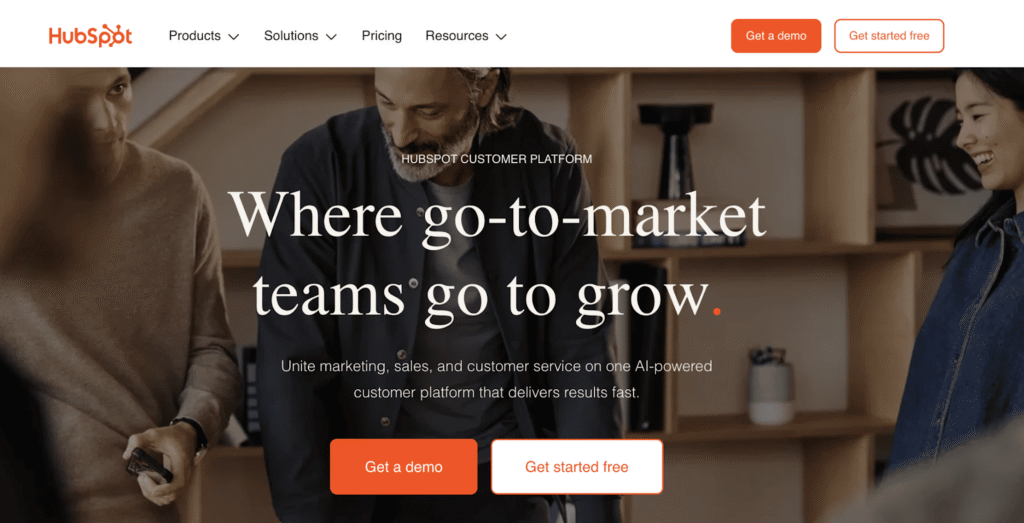
HubSpot is an all-in-one marketing, sales, and service platform where email marketing is one part of a much larger ecosystem. It’s designed for businesses that want to connect their marketing directly to a central customer database.
Key features of HubSpot:
- Native CRM integration: This is HubSpot’s most significant advantage. Every email is linked to a contact’s comprehensive history, including details such as website visits, support tickets, and sales calls.
- Sales and service alignment: It’s designed for B2B and service businesses, enabling you to align marketing, sales, and support teams in one platform.
- All-in-one platform: It goes far beyond email to include landing pages, a CMS, social media, and blogging, making it a true, albeit complex, all-in-one hub.
Limitations of HubSpot:
- High cost: The more advanced plans, which unlock the real automation features, are significantly more expensive than Mailchimp’s.
- Steep learning curve: The platform is massive and can be overwhelming. Mailchimp is far simpler for just sending newsletters.
HubSpot pricing:
The free tools are great, but the real marketing automation and features are locked behind the expensive Marketing Hub plans. Mailchimp’s Standard plan is a fraction of the cost for similar automation features.
5. Klaviyo

Klaviyo is a top-tier ecommerce marketing platform and one of the most powerful services like Mailchimp. Similar to Omnisend, it’s built exclusively for online stores, focusing on in-depth data analytics and segmentation.
Key features of Klaviyo:
- Deep ecommerce data: Klaviyo is better than Mailchimp for ecommerce because it pulls in all your store data, tracking website browsing and purchase history in real-time.
- Predictive analytics: It can predict a customer’s next order date, lifetime value, and churn risk, which Mailchimp’s platform does not do.
- Advanced ecommerce segmentation: This data allows for hyper-specific segmentation that is far more granular than Mailchimp’s. For example, you can have a segment of customers who bought a specific shirt and live in New York.
Limitations of Klaviyo:
- High price tag: It’s one of the most expensive tools on the market, often costing significantly more than Mailchimp for the same list size.
- Ecommerce only: It’s not the right choice for businesses outside of ecommerce. Mailchimp is more versatile since it works well for any business model, not just online stores.
- High complexity: It’s a powerful and complex tool that can be difficult for beginners to master without dedicating significant time.
Klaviyo pricing:
Klaviyo’s pricing is based on both the number of contacts and the volume of emails sent. In most cases, it’s more expensive than Mailchimp, but ecommerce stores justify the cost with a higher ROI from its advanced features.
6. ActiveCampaign
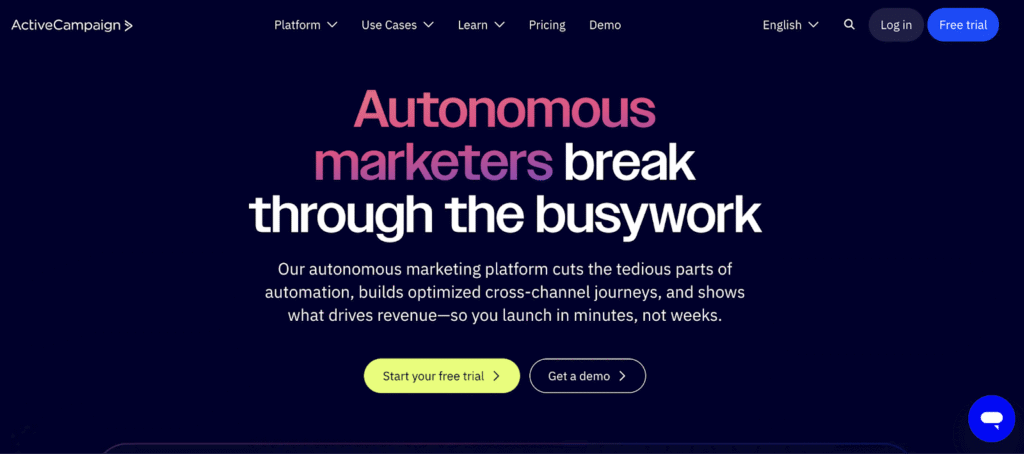
ActiveCampaign is a customer experience automation platform that excels at complex, multi-step marketing sequences. It combines powerful email marketing with CRM and sales automation, making it a favorite among B2B businesses.
Key features of ActiveCampaign:
- Best-in-class automation: Its visual workflow builder is more powerful and flexible than Mailchimp’s, allowing for complex “if-this, then-that” logic across multiple channels.
- Built-in sales CRM: It includes a CRM with a sales pipeline, lead scoring, and deal management. This is a feature Mailchimp attempts to offer, but its CRM is more of a basic audience management tool for email marketing.
- Cross-channel automation: You can automate email, SMS, and even on-site messages from one workflow, which is more advanced than Mailchimp’s email-centric automation.
Limitations of ActiveCampaign:
- Overwhelming for beginners: All that power comes with complexity, and the interface can be confusing for simple tasks compared to Mailchimp.
- Higher entry cost: It’s more expensive than Mailchimp’s entry-level plans, though it offers more features for the price.
ActiveCampaign pricing:
ActiveCampaign’s Starter plan starts at $15/month and is competitive. However, to get the CRM and advanced automation, you’ll need the Plus plan for $49/month.
7. Brevo (formerly Sendinblue)
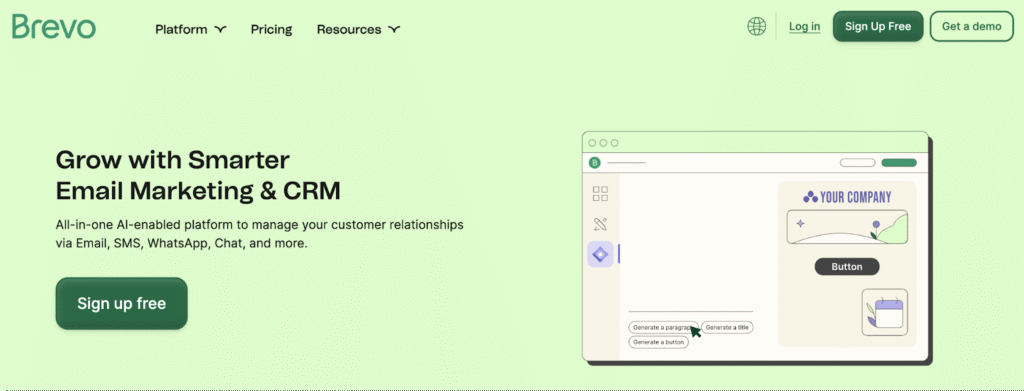
Brevo is an excellent Mailchimp alternative for businesses with large contact lists that don’t send daily emails. It’s a strong all-in-one platform that has expanded from email to include CRM, SMS, and landing pages.
Key features of Brevo:
- Send-based pricing: This is its standout feature. Brevo charges based on the number of emails you send, not the number of subscribers, which is a significant cost-saver for large, less-frequently emailed lists.
- Strong transactional emails: It includes a reliable SMTP service for receipts and password resets in its main plans. Mailchimp handles this through a separate, paid add-on.
- SMS marketing included: SMS is a native channel in Brevo’s automation workflows, whereas Mailchimp’s SMS is a US-only add-on with a separate credit system.
Limitations of Brevo:
- Simpler automation: The automation builder is not as advanced as ActiveCampaign’s or even Mailchimp’s Standard plan.
- Low free plan sending limit: While the unlimited contacts on the free plan are great, the daily send limit is low (300 emails per day), making it unusable for large sends.
Brevo pricing:
This is where Brevo wins for many. You can have unlimited contacts on its Free and Starter plans. For comparison, a list of 10,000 contacts on Mailchimp’s Standard plan costs over $130/month. On Brevo, you could send 20,000 emails for just $25/month.
8. MailerLite

MailerLite is renowned for its elegant simplicity, clean design, and exceptional features tailored for creators and bloggers. It’s designed to be as intuitive as possible, removing the clutter that many users experience with Mailchimp.
Key features of MailerLite:
- Superior ease of use: Its drag-and-drop editor is modern, intuitive, and just more straightforward to use than Mailchimp’s, which many find cluttered.
- Generous free plan: Its free plan includes features Mailchimp charges for, like a website builder, landing pages, and basic automation (up to 500 subscribers).
- All-in-one creator tools: It’s a fantastic all-in-one tool for those just starting who need a landing page, website, and newsletter tool in one package.
Limitations of MailerLite:
- Basic automation and reporting: If you require complex, multi-step sequences or in-depth analytics, Mailchimp’s paid plans offer more robust and scalable options.
- Weaker ecommerce features: Its ecommerce integrations are not as deep or powerful as those found in Mailchimp, Klaviyo, or Omnisend.
MailerLite pricing:
MailerLite’s free plan covers you for up to 500 subscribers and 12,000 emails per month. Its paid plans start at $13.50/month and are significantly more affordable than Mailchimp’s across the board as well.
9. Pipedrive
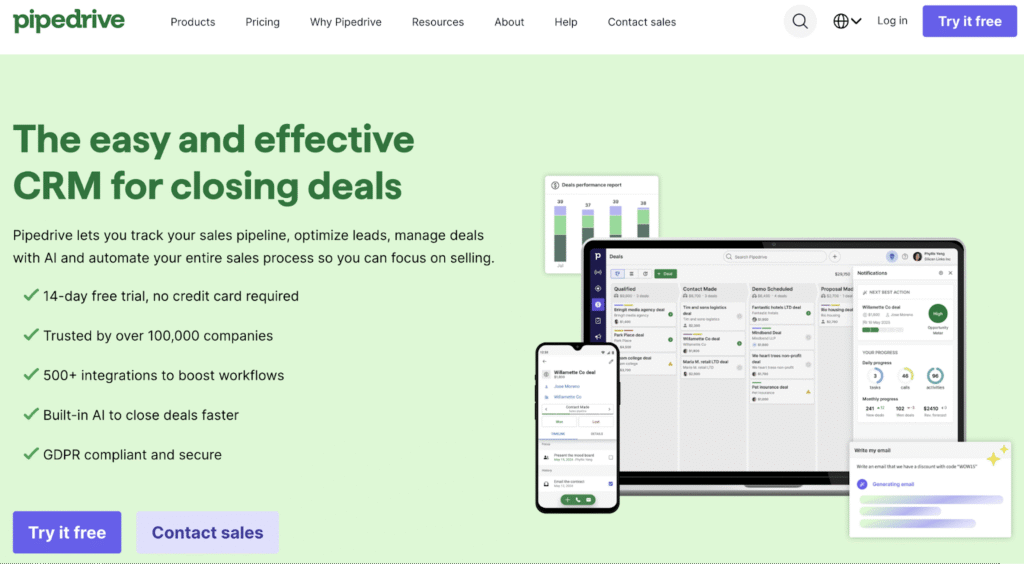
Pipedrive is a sales-focused CRM first and foremost, not a traditional email marketing tool. It offers an email marketing add-on called Campaigns for businesses that want to manage all communication within their sales pipeline.
Key features of Pipedrive:
- Sales pipeline alignment: Its main strength is sending targeted campaigns to leads based on their stage in the deal within the CRM.
- Dedicated sales CRM: More advanced than Mailchimp’s all-in-one claim, Pipedrive is a dedicated sales CRM built to manage deals, activities, and sales reps.
- Activity-based tracking: It connects email sends directly to sales activities and deal progress, which is a B2B focus that Mailchimp lacks.
Limitations of Pipedrive:
- Not a standalone tool: Email marketing is a CRM add-on. It lacks the creative features, template libraries, and newsletter-focused automations of Mailchimp.
Pipedrive pricing:
The Campaigns feature is an add-on to the main Pipedrive CRM subscription. This makes it an expensive choice if all you need is email marketing.
10. Constant Contact
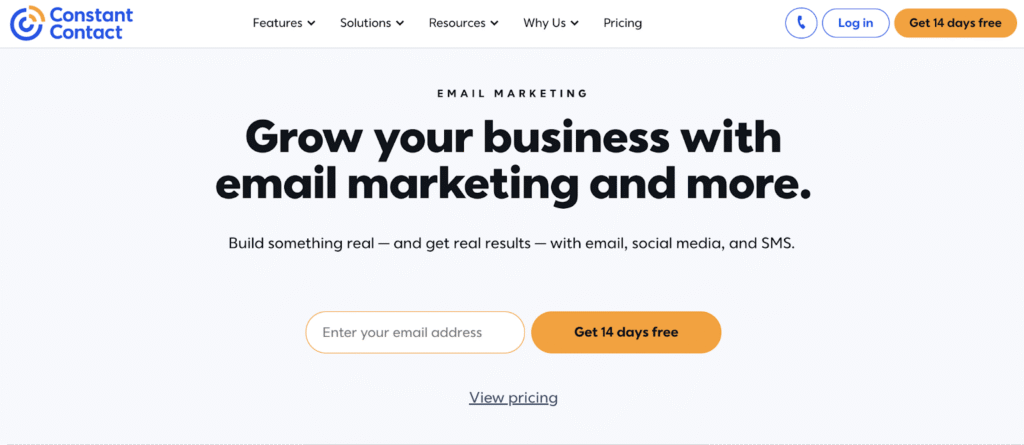
Constant Contact is one of the original email marketing tools and a long-time Mailchimp competitor. It’s known for high deliverability and strong customer support, making it a trusted choice for small businesses.
Key features of Constant Contact:
- Human phone support: Their key differentiator is the level of support. They offer real phone support, a huge benefit for small business owners who want to speak with a live representative.
- Niche event management: It offers unique features for event management, such as ticket sales and surveys, which are more developed than those in Mailchimp.
- High deliverability: The platform has a long-standing reputation for achieving high deliverability rates.
Limitations of Constant Contact:
- Dated interface: The platform, editor, and templates feel dated and lack the flexibility of MailerLite or Mailchimp.
- Lower feature value: You pay more for fewer features. For example, basic A/B testing is included in Mailchimp’s most affordable paid plan, but Constant Contact restricts this feature to its more expensive plans.
Constant Contact pricing:
Its Core plan starts at $9.99/month (based on contacts), which is more than Mailchimp’s Essentials plan, and its features are more limited.
How to choose the best tool for email marketing?
Choosing the right tool from this list of alternatives to Mailchimp depends on your specific business needs and budget. You’ll need to balance the features you want, like advanced automation or ecommerce tools, with how much you’re willing to pay as your list grows.
- Consider your business model: Are you an ecommerce store, a B2B service, or a content creator? Ecommerce stores should look at Omnisend or Klaviyo. B2B companies will benefit more from HubSpot or ActiveCampaign. Bloggers and creators will love the simplicity of Hostinger Reach.
- Look at your budget and the pricing model: If you have a large list but send fewer emails, Brevo will save you a lot of money. If you’re on a tight budget, MailerLite’s free plan is an excellent option. Don’t just look at the starting price – check how much it costs for 5,000 or 10,000 subscribers to get an idea of pricing as you grow.
- Think about your automation needs: Do you just need to send a weekly newsletter, or do you require complex welcome sequences and abandoned cart emails? For simple automations, Hostinger Reach is perfect. For advanced, behavior-based workflows, you need ActiveCampaign or Omnisend.
- Consider ease of use: How much time do you want to spend learning a new tool? MailerLite and Hostinger Reach are built for simplicity. ActiveCampaign and Klaviyo are powerful but have a steeper learning curve. It’s best to sign up for a free trial and see how the interface feels to you.
- Check integrations: Create a list of the other tools you use, such as your website platform and payment processor. Check if the email tool connects to them directly. While Zapier can bridge gaps, native integrations are almost always more reliable.
Beyond email tools: What else drives email marketing success?
Picking the right tool from this list of Mailchimp alternatives is a critical first step, but the tool itself doesn’t guarantee success.
A feature-rich platform like Klaviyo won’t help if your emails aren’t valuable. And a simple yet effective tool like Hostinger Reach can be potent if you have a strong connection with your audience.
The real driver of success is your strategy. This means understanding who your audience is, segmenting them into meaningful groups, and sending them content that they actually want to read.
A successful email strategy focuses on building trust, not just making sales. It’s about consistency, providing value, and respecting your subscribers’ inboxes. Your email tool is just the engine – your strategy is the one behind the wheel.
All of the tutorial content on this website is subject to Hostinger's rigorous editorial standards and values.


